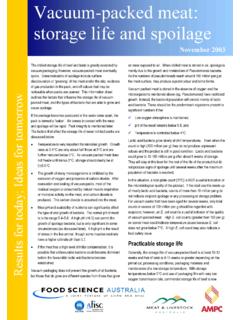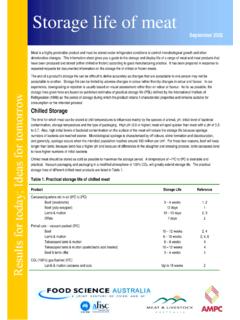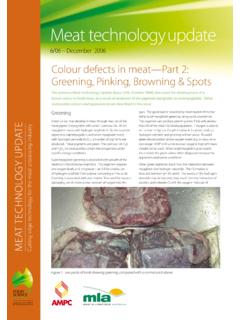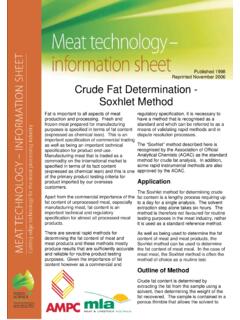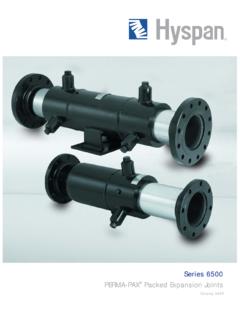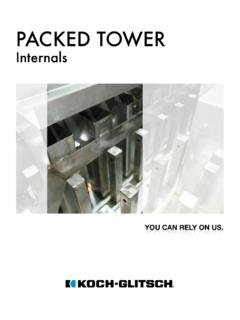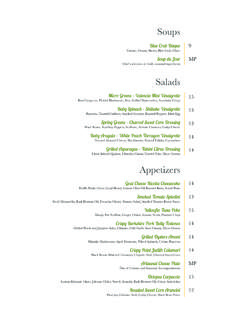Transcription of Vacuum-packed meat: storage life and spoilage
1 The chilled storage life of beef and lamb is greatly extended by vacuum packaging; however, Vacuum-packed meat eventually spoils. Some indicators of spoilage include surface discolouration or greening of the meat and/or the drip, evidence of gas production in the pack, and off odours that may be noticeable when packs are opened. This information sheet outlines the factors that influence the storage life of Vacuum-packed meat, and the types of bacteria that are able to grow and cause spoilage . If the package becomes punctured or the seals come apart, the pack is termed a leaker . Air comes in contact with the meat and spoilage will be rapid. Pack integrity is mentioned later. The factors that affect the storage life of meat in intact packs are discussed below: Temperature is very important for microbial growth. Growth rates at 0-1 C are only about half those at 5 C and are further reduced below 0 C.
2 As Vacuum-packed meat does not freeze until minus 2 C, storage should ideally be at 0 C. The growth of many microorganisms is inhibited by the exclusion of oxygen and presence of carbon dioxide. After evacuation and sealing of vacuum packs, most of the residual oxygen is consumed by natural muscle respiration or microbial activity on the meat, and carbon dioxide is produced. This carbon dioxide is absorbed into the meat. Meat pH and availability of nutrients can significantly affect the type of and growth of bacteria. The normal pH of meat is in the range A high pH (> ) can permit the growth of spoilage bacteria, but is only significant in some circumstances (as discussed later). A high pH is the result of stress in the live animal, though some muscles routinely have a higher ultimate pH than If the meat has a high level of initial contamination, it is possible that unfavourable bacteria could become dominant before the favourable lactic acid bacteria become established.
3 vacuum packaging does not prevent the growth of all bacteria, but those that do grow are different species from those that grow on meat exposed to air. When chilled meat is stored in air, spoilage is mainly due to the growth and metabolism of Pseudomonas bacteria. As the numbers of pseudomonads reach around 100 million per g at the meat surface, they produce a putrid odour and slime forms. Vacuum-packed meat: storage life and spoilage November 2003 Vacuum-packed meat is stored in the absence of oxygen and the microorganisms mentioned above (eg. Pseudomonas) have restricted growth. Instead, the bacterial population will consist mainly of lactic acid bacteria. These should be the predominant organisms present in significant numbers if the: Low oxygen atmosphere is maintained, 9 9 9 pH of the meat remains below , and Temperature is controlled below 4 C.
4 Lactic acid bacteria grow slowly at chill temperatures. Even when the count is high (100 million per g) they do not produce unpleasant odours and the product is still in good condition. Lactic acid bacteria could grow to 10-100 million per g after about 6 weeks of storage . They will stay at this level for the rest of the life of the product but do not produce signs of spoilage until several weeks after the maximum population of bacteria is reached. In this situation, a total plate count (TPC) is NOT a useful indication of the microbiological quality of the product. If the total count is made up of mostly lactic acid bacteria, counts of more than 10 million per g do not indicate incipient spoilage or any processing or storage problem. For vacuum packs that have been aged for several weeks, only total counts in excess of 100 million per g should be regarded with suspicion; however, an E.
5 Coli count is a useful indicator of the quality of Vacuum-packed meat. High E. coli counts (greater than 100 per g) on stored meat could indicate temperature abuse because E. coli does not grow below 7 C. A high E. coli count may also indicate a food safety issue. Practicable storage life Generally, the storage life of Vacuum-packed beef is at least 10-12 weeks and that of lamb is 8-10 weeks or greater depending on the primal cut, processing conditions, packaging materials and maintenance of a low storage temperature. With storage temperatures below 0 C and use of packaging film with very low oxygen transmission rate, commercial storage life of beef is now frequently considerably in excess of 12 weeks. The meat industry guidelines, as published by the Meat Standards Committee of ARMCANZ (Agricultrual and Resource Management Council of Australia and New Zealand) suggest the following microbiological levels for fresh meat: Category TPC* /g E.
6 Coli /g Excellent <1,000 Not detected Good 1,000 10,000 1 10 Acceptable 10,000 100,000 10 100 * Total aerobic plate count If the total aerobic count on fresh meat is within the Good category before vacuum packaging, and if cold chain parameters are maintained, then the storage lives mentioned above should be achievable. storage at 0 C or below is recommended whenever possible because storage at higher temperatures will reduce the storage life of the product by up to 50% if held at 5 C. Nature of spoilage A range of odours and flavours has been reported for vacuum -packaged beef and lamb. Aged Vacuum-packed , commercially sterile meat will eventually develop cooked aromas that are described as sour, milky or cheesy and flavours that are sour, lactic-like or caramel-like.
7 As stated earlier, lactic acid bacteria will dominate the bacterial flora of these packs. After 14-16 weeks, bitter or liver-like flavours develop. Even though spoilage may have occurred after extended storage , it is most unlikely that any pathogenic bacteria will have grown on Vacuum-packed meat if the meat has been stored at less than 4 C. Very occasionally, meat from a pack that is dominated by lactic acid bacteria is characterised by an aroma of hydrogen sulphide that rapidly dissipates when the meat is removed from the pack. Certain isolates of Lactobacillus have been shown to produce hydrogen sulphide. If Vacuum-packed meat has a pH greater than , if the storage temperature is 5-10 C, or if there is residual oxygen in the pack due to using a packing film with a high oxygen transmission rate, there may be an increased growth of spoilage bacteria such as Brochothrix thermosphacta, Shewanella putrefaciens, and psychrotrophic enterobacteria.
8 In high pH meat, off odours may be detected when the bacterial count is just over 1 million per g at the surface. These bacteria will cause a range of off odours and off flavours, and in the case of Shewanella putrefaciens, spoilage is indicated by a greening of the meat surface and a strong hydrogen sulphide odour (like rotten eggs). When Brochothrix is a major component of the bacterial population, the aroma is variously described as cheesy , dairy like or bready . Odours and flavours in high pH meat from spoiled vacuum packs have been described as faecal or sulphury . Hydrogen sulphide and various other sulphur containing compounds have been detected in such meat. Enterobacter and other enterobacteria have been shown to produce these. If off odours are evident when vacuum packs are opened, selective counts of these organisms can be useful in identifying why storage problems have arisen.
9 With the combination of low temperature, low oxygen availability and low pH, lactic acid bacteria will dominate the bacterial flora on the meat, as stated earlier. Other bacteria cannot grow or grow very poorly in these conditions and do not spoil the meat. Random spoilage of Vacuum-packed cuts Random premature spoilage of individual vacuum -packs in cartons indicates that spoilage is probably not a direct result of temperature abuse; temperature abuse is more likely to result in whole cartons being spoiled. If pack leakage can be ruled out, it is more likely that random spoilage has occurred because of a higher pH in the spoiled cut. As discussed previously, a higher pH will cause spoilage sooner because microbial flora (other than the more favourable lactic acid bacteria) will develop. Probably the most common cause of premature spoilage of vacuum -packaged meat is loss of integrity.
10 Leakers are usually noticeable because leakage is normally accompanied by loss of vacuum in the pack. Packs of boneless primals may be leaking because of poor seals or because of puncture or scuffing of the film during processing or transport. With bone-in primals, leakage is often due to sharp ends of bones piercing the pack and poor seals. Cut bone ends and smearing of bone dust on ends of cuts are also a source of spoilage because bone marrow provides a high pH environment. Further information storage life of meat, Meat Update Information sheet Egan, A. F., Eustace, I. J., Shay, B. J. (1988) Meat packaging maintinaing the quality and prolonging the storage life of chilled beef, pork and lamb. Proceedings of Meat 88.
